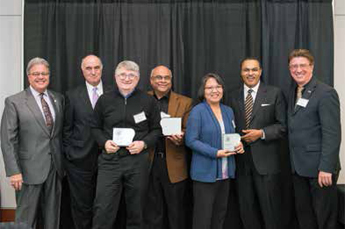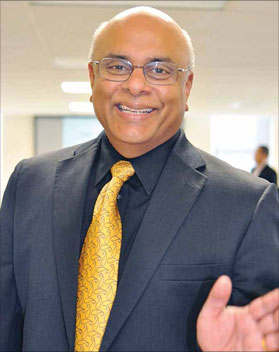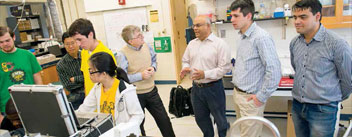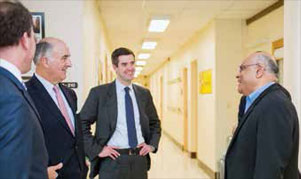At the Plenary session of the IBAB Startup Bio 2017 held in Bengaluru, Dr Govind Rao, professor of Chemical & Biochemical Engineering and Director of the Center for Advanced Sensor Technology (CAST) at the University of Maryland, Baltimore County, spoke on “Disruptive Innovations to transcend health care challenges,” offering the big picture to young start ups and entrepreneurs on what it takes, commitment to innovation, the pitfalls to avoid and the lessons he learnt on his journey
 From left to right: Robert Caret, Michael Gill, Dan Kostov, Govind Rao at the time of VakSea signing an Express License Agreement with (Source - http://research.umbc.edu/otd-news-and-features/) UMBC
From left to right: Robert Caret, Michael Gill, Dan Kostov, Govind Rao at the time of VakSea signing an Express License Agreement with (Source - http://research.umbc.edu/otd-news-and-features/) UMBCThere’s huge focus on disruptive innovation in my lab at University of Maryland, Baltimore County (UMBC). Our core competence is developing innovation sensor technology. What really drives us is disruptive innovation. We believe in game-changing approaches that can cause paradigm shifts. We are really focused on reducing healthcare costs. We use a highly interdisciplinary approach. Ultimately, what drives us is coming up with technology that has a broad humanitarian impact. I will talk you through some case studies and also some lessons learnt, especially for the young entrepreneurs out there.
All the non-invasive sensor technology used in bioreactors came out of my lab. And this was licensed exclusively to Sartorius. That was the mistake. I will never license anything exclusively again as it discourages innovation. It builds walls and prevents others from adopting technology. If you want innovation to flower, you need a generous cross licensing strategy. Take a leaf from an auto industry page book or from the computer industry page book, where many patents are instantly cross licensed. Because what happened with this patent is that it’s reaching all the way to the Federal Court of Appeals because when you license something exclusively, you inevitably get infringers or people who challenge the patent.
One day, General Electric’s Chief Engineer Steve Falk visited my lab. He runs GE’s maternal infant care division. Steve kept staring at a poster, which depicted the molecule which changes its brightness as a function of temperature. Excited, he said, “My God, you have the perfect solution for a big problem.” More pre-term babies are being born as women defer childbirth and take fertility treatments. 10% of the babies born are pre-term. A pre-term baby is very delicate. Only way to help it survive is to put it into an incubator. You need to put the temperature sensor on the body to monitor the baby’s temperature. Every day, when you take off the sensor, it’s painful as the baby’s skin is thin. So Steve said, “If you can make that molecule of yours a non-contact temperature sensor, boy, do we have a winning product.” The project got funded. Word went up GE’s management chain, and Jeff Immelt, the CEO of GE visited the lab. He said you guys have really refined cost reduction to an art form. On the spot, he funded us to find out what the opportunities at the base of the pyramid are.
As a target, we looked at the neo-natal energy triangle, which actually is the energy triangle for any human being. If you get a person’s temperature, his or her glucose level, CO2 and Oxygen profile, you pretty much know his/her metabolic status. So we embarked on an ambitious development programme-this was the glucose binding protein that our lab had been studying for a number of years. What’s unique is that it’s an ABC transporter protein and so it is exquisitely sensitive to glucose. Notice the binding affinities are on the micromolar levels and in blood and you have millimolar levels of glucose, so it’s a thousand fold more. That compared to glucose oxidase makes it even more sensitive. Currently, getting a baby’s glucose is like sticking the heel of an adult with a 2-inch blade. The nurse squeezes the baby’s foot like a lemon, and gets a drop of blood while the baby’s screaming. We said if the baby’s skin is so thin, maybe if we put some buffer on the skin, we should be able to extract enough glucose and make a measurement without a blood draw. That’s the key innovation. We’ve now started automating the device. Our preliminary papers show the babies are seeing a lot more glucose flux. It’s hard to get permission for trials on babies. Even with adults, we are seeing enough glucose and we built instruments in the lab to measure the glucose, all compact, all low cost, and we have done some validation studies. The data we have is given from volunteers.
All the non-invasive sensor technology used in bioreactors came out of my lab. And this was licensed exclusively to Sartorius. That was the mistake. I will never license anything exclusively again as it discourages innovation. It builds walls and prevents others from adopting technology

Abdul Kalam’s 20-20 talks of India is one. Unfortunately, diabetes is also one of them. Even 10 Biocons cannot meet the demand of a 100 million diabetics. Clearly, disease management, disease prevention’s a sweet spot. If we can have an automated glucose sensor that regularly charts the population to see when diabetes is coming in, early detection can help manage it through diet and exercise. Similarly, for ventilating a baby. When a baby is in an incubator, they put oxygen in but the levels are not monitored. So you can have extremely serious consequences due to too much oxygen or too little oxygen.
Earlier, for a blood draw, the existing sensor required heating the skin to 42 degrees. So, taking the measurements meant burnt skin. We and came with a new way of taking the measurement. We exploited Fick’s law, the fact that oxygen and CO2 must be readily diffusing across the skin. This is the key innovation-a hollow sampler like stethoscope is put against the skin, you flush it with nitrogen. That gives you a zero background. You flip a valve and circulate the gas diffusing across the skin past an oxygen and CO2 sensor. In a few seconds, you can measure the slope of the curve. That tells you the rate of diffusion of oxygen and CO2. This gives arterial blood gas concentration.
We developed a low cost instrument, trained the nurses in the neonatal care unit. The sampler is held against the baby’s skin, and right off the bat, you can see how beautifully this non-invasive measurement correlates with an actual blood gas measurement. This will be game changing. We have also started expanding this for adults. For a marathon runner, you can easily monitor the status of your muscles, how good they are performing with your CO2 measurements. Our students are coming up with a compact device. It also works for diets. It’s very sensitive to the food you eat. If it’s a glucose shot, then your CO2 through your skin goes up. With a high protein, you have a more modulated response. This can potentially help manage your diabetes and respiratory diseases. Since asthma is an enormous problem in the world, especially in the poorer sections, we are coming up with a network sensor of measuring the CO2 by low cost sensors.
I visited Nandan Nilekani to see how he can ride the digital India wave to incorporate all smart sensors and add value to preventive healthcare. Aadhaar’s just a starting point. Imagine if you could get digital health integrated into and its game changing ability.
I visited Nandan Nilekani to see how he can ride the digital India wave to incorporate all smart sensors and add value to preventive healthcare. Aadhaar’s just a starting point. Imagine if you could get digital health integrated into and its game changing ability
 Work on to develop wearable system to track asthma triggers in pediatric patients
Work on to develop wearable system to track asthma triggers in pediatric patientsI met army doctor Colonel Geoffrey Ling, Retd., one of the world’s leading experts on traumatic brain injury. Geoff served five times in Afghanistan and Iraq; he’s also the brain behind DARPA’s (Defence Advanced Research Projects Agency) prosthetic arm-an amazing mind controlled prosthetic, an arm controlled by a computer that translates brain impulses into motion. When in Afghanistan, he observed long lines of villagers seeking medical treatment everywhere, and wanted to do something about it. He wanted the ability to make biologics and from molecules at the point of care in under 24 hours. Geoff said he was tired of the pharma business model, the whole cold chain and then charging highly, when you know it’s not that expensive. He wanted to disrupt that. We were one of the three teams that put together the proposal. The goal was to replace a conventional pharmaceutical plant and replace that 1 acre footprint and several hundred million dollars by a compact device the size of a suitcase.
I thought it was ridiculous. It takes 24 hours to grow a cell culture. But, this is DARPA. Because of them, GPS exists, the Internet exists. Our partner Thermo Scientific commercialised the CHO cell free extract. You take your cells and strip off the nucleus from the cell, everything else stays in the extract. So this mixture can synthesise protein as soon as you add DNA.
What’s more amazing was the ability to take this extract and freezedry it. The cold chain is gone. You can make your biologic if you want and you don’t have any issues of having the cold chain. This extract is remarkably stable. It’s like milk powder. Just add water, add buffer and away you go. Students were so excited, they just added a GFP gene to it with a buffer. And you can see right after that the vial glows green while the one in which there was no DNA still stays clear. Then, the students said, what if we don’t control the temperature? What if it’s a soldier who uses his or her body heat to produce the DNA and that also works? Imagine, you have a vial that you can reconstitute and get protein expression under 8 hours. That will be a paradigm shift.
We were two years ahead of schedule. We did our first field demonstration for Geoff Ling. He brought an army medic, Dr. Robert Mabry. Now it is almost ready to make injectable therapeutics. Our video shows that in 20 minutes, you are purifying the protein that’s potentially ready to inject into the population. You can see it binding to the column packing and then eluting. It’s almost like cooking a meal. It’s beyond Star Wars. At this stage, the FDA emerging tech team is giving us feedback. Obviously, everything’s going to be a single use system. It’s going to be a highly controlled system. It’s like a VHS cassette. Put it in the VHS cassette recorder and eight hours later, your protein’s ready to inject into patients.
Those of you interested in rare diseases - the sad truth is no one makes stuff for them as there’s no economic incentive. What we have done is to completely change the paradigm. Anyone who wants to produce any protein can do so at the same cost. Cost is no longer an issue. That will be a game changer. Because as a small biotech or start-up, if you want to make a clinical trial, you can find a CMO or someone help you to make the stuff or you can make your own. Or get a physician who can run a 20-patient clinical trial and you can get much greater velocity. It’s going to do to medicine what Aadhaar is doing to banking.
When Zika became the panic of the day, we got the gene synthesized. The conventional process would have taken a couple of weeks - we could make the Zika antibody in under 8 hours.
Geoff brought John Sculley, former CEO of Pepsi and Apple to the lab. He’s interested in disruptions in this. He says, “Healthcare is the only space where I see people spend more and more and get less and less. I am going to change that.”
 Prof. Govind Rao with Maryland Secretary of
Commerce Mike Gill and Brady Walker
Prof. Govind Rao with Maryland Secretary of
Commerce Mike Gill and Brady WalkerAnother thing that drives us, and me personally, is that all of us can afford much of the day to day basis medicines. But if you look at a map of the world normalized to people who live on less than a dollar a day, that’s about a billion people. Extend that to 10 dollars a day, the map won’t change much. That’s 5 billion people. The only way we can reach them is by what I call micro-retail healthcare. Take a page from the Hindustan Lever selling single use shampoo, and deliver things really cheaply, really efficiently. That’s what we are trying to do, develop technologies.
Another thing I learnt was the horrific notion of infant mortality. Every 10 seconds, a baby dies. That’s tragic, more so because it is preventable. They die because of hypothermia or sepsis, two leading causes. So, one of my class projects was to create a low cost incubator. I assigned the students to design, and we built the first generation. I took them on a fact finding mission, paid by Jeff, to go survey the rural healthcare landscape.
This is a valuable lesson for you young startup guys out there: “Go see for yourself.”
Another thing I learned-don’t talk to the experts. Engage someone who can directly talk to the consumers. I learned that women communicate very differently with other women. We had a translator. She established a rapport with other women. The kind of information they gave: they said it’s not the doctor you must convince, it’s the mother-in-law, she decides things. No marketing text will ever tell you that; so, get the last mile information yourself. They also said they had highend incubators, but no service for them - they were lying in disrepair. So our incubators can be easily serviced and they need something cheap enough to send the mom and baby home in. The typical rural women having babies are daily labourers. If they don’t work, they don’t eat. Send the baby home with them, its chance of survival’s better because they can’t stay in the hospital for two months. So, we came up with a cardboard incubator that will cost less than `300. And have a fixed unit servo controller for about `20,000.
We are now allying with Indian hospitals for clinical trials. Many want to buy this. But I won’t sell until the safety trails are done. We are partnered with Phoenix Medical Systems. I’m trying to contact the Karnataka state government because my students keep developing sensors. They are under-graduates, so I have a low cost innovation model - my outstanding engineers work for free. Nobody can compete with that. My students are build next generation sensors. The idea is to transmit the image and the weight of the baby to a centralized facility so you can check the baby’s weight gain. This could be a game changer if piggybacked on India’s IT infrastructure. Even with a shortage of physicians you can come up with an app like a Tinder for a more noble purpose.
People always ask me for words of wisdom. Here are some:
The Head of the National Institute for Drug Abuse also visited us, worried that 50,000 Americans die every year due to prescription drug overdose. These are not drug abusers, but people who use prescribed painkillers; basically, the heart stops beating. Our sensors could give an early warning when someone stops breathing because their CO2 level will spike.
By Geetha Rao